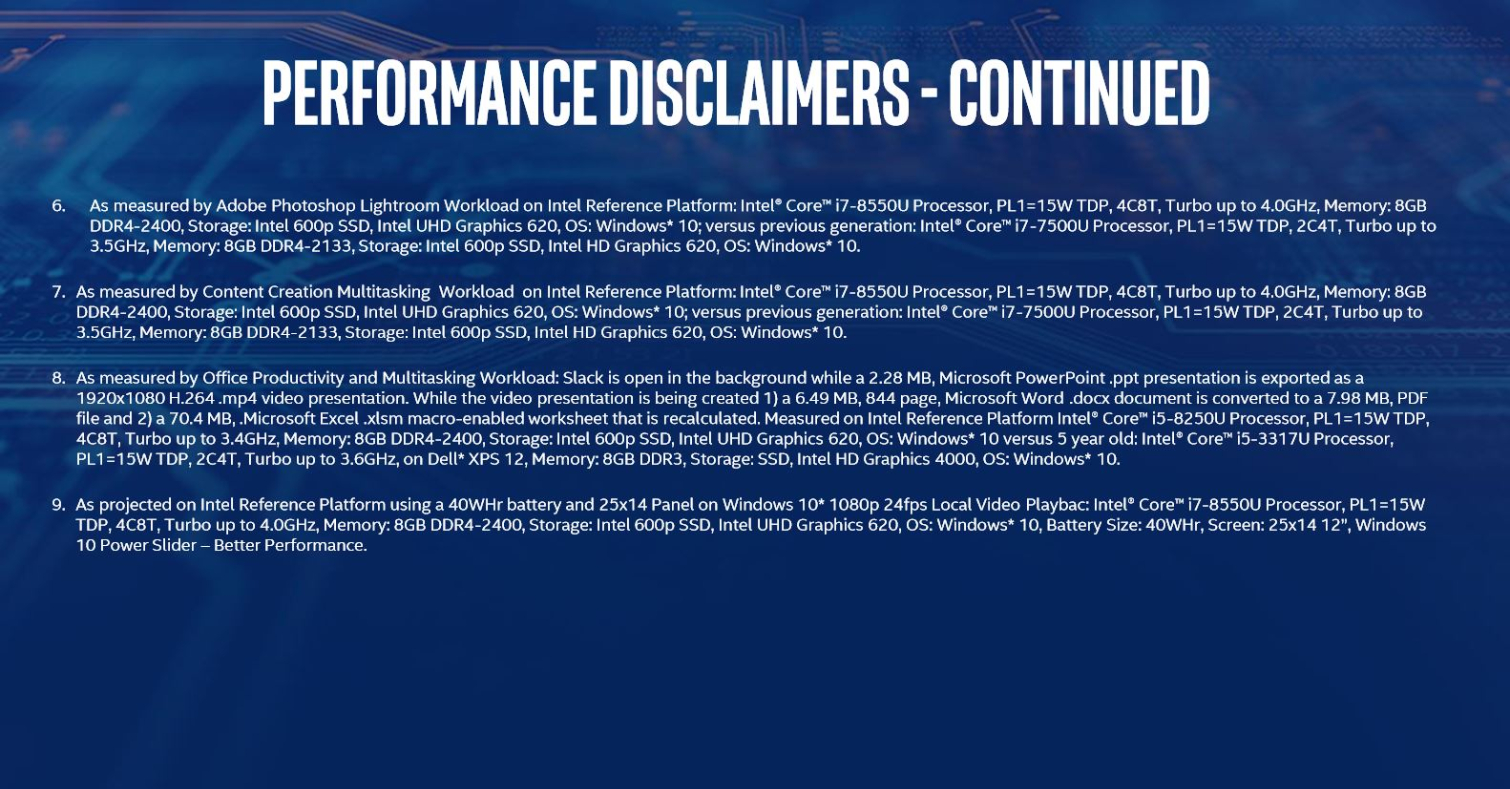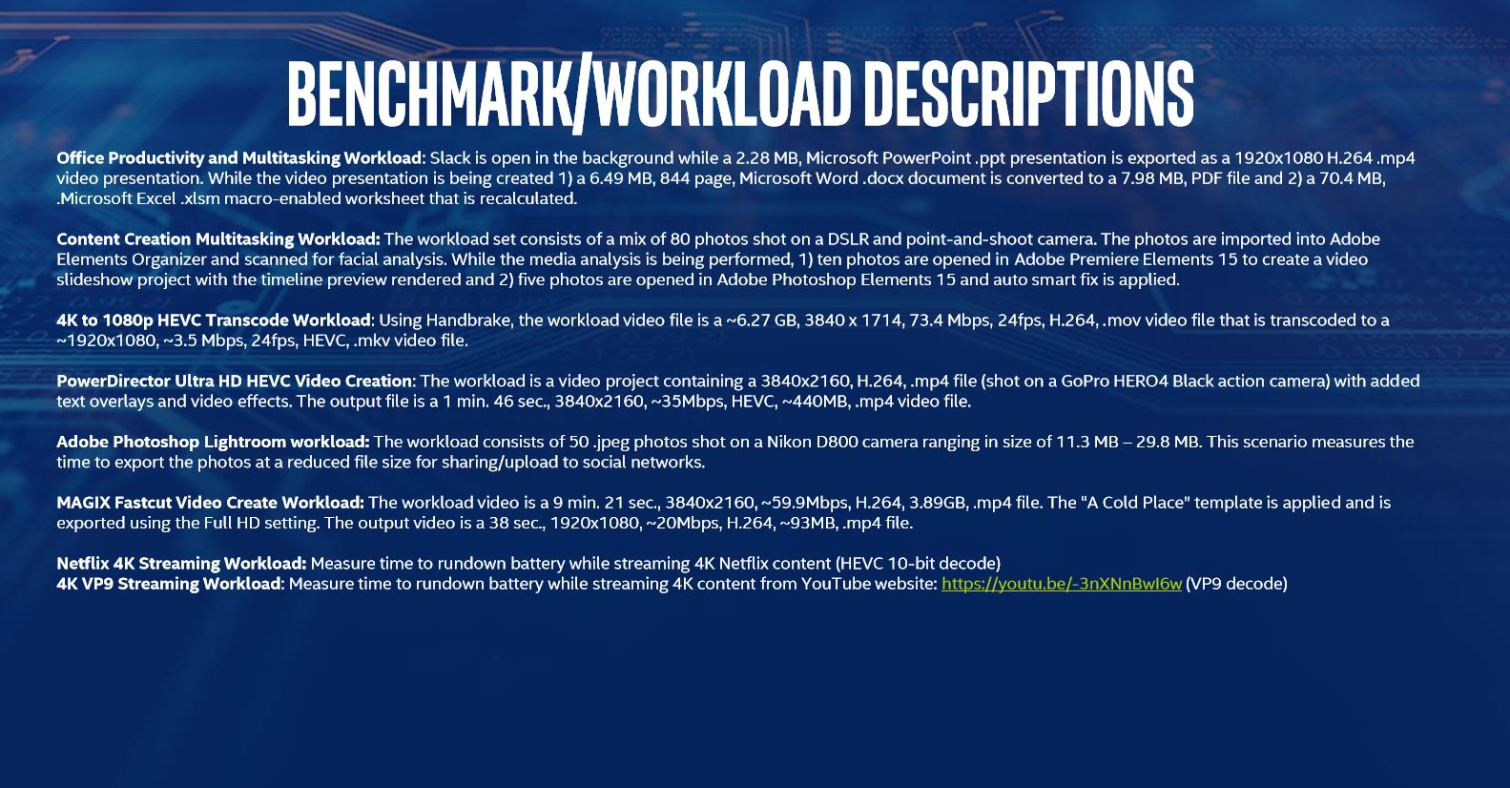Intel Unveils 8th-Generation U-Series Processors, Kaby Lake Refresh Debuts
These are not the Coffee Lake processors you're looking for, but Intel's leading 8th generation processors bring double the cores and threads to the i5 and i7 lineups, which Intel claims offers up to 40% more performance. As with all vendor-provided performance data, the claims do come with some notable caveats, though.
The biggest surprise of Intel's 8th generation processors, aside from the addition of more cores within a similar thermal envelope, is that the processors are coming to market with three separate architectures in tow, including the 14nm+ Kaby Lake-R (refresh), 14nm++ Coffee Lake, and 10nm Cannon Lake.
Intel's 8th Generation begins with 14nm+ Kaby Lake-R i5 and i7 processors, which utilize the same underlying Kaby Lake architecture that is already on the market today. The refresh models will make their way to market in September, followed by the desktop Coffee Lake models in the fall. Intel will continue to roll out new 8th-gen products, including server models and 10nm processors, next year.
The new strategy denotes a fundamental shift in Intel's go to market strategy, which the company summed up in short statement:
8th Gen as a family of processors will include multiple architectures – Kaby Lake, Coffee Lake and Cannon Lake – in addition to packing in more power and performance in 14nm while delivering on our promise of 10nm. These are purpose built to serve different segments. Like we’ve said, we’re committed to delivering an annual cadence of products to our customers. Does it look different this year for 8th Gen? Sure. ...With 8th Gen, we had to reimagine what “generation” means, look through the lens of what consumers and business customers should expect with the common denominator remaining true no matter which 8th Gen device is used: outstanding performance, immersive entertainment and simple convenience. These focus areas characterize the 8th Gen processor family as a cohesive family, rather than being defined by a specific microarchitecture or process node.
The Kaby Lake Refresh
The first salvo begins with Kaby Lake-R models built on the 14nm+ process, and Intel's 15W U-Series processors lead the charge. These processors are destined for thin and light laptops, 2-in-1s, convertibles, and mini systems. There will follow 4.5W Y-series chips for ultralight, clamshells, and fanless designs, along with 45W H-Series models for high-performance laptops and mobile workstations. Of course, the S-Series desktop products round out the product stack.
| Header Cell - Column 0 | KBL-R i7-8650U | KBL i7-7600U | KBL-R i7-8550U | Kaby Lake i7-7500U | KBL-R i5-8350U | KL i5-7300U | KBL-R i5-8250U | KL i5-7200U |
|---|---|---|---|---|---|---|---|---|
| Cores / Threads | 4 / 8 | 2 / 4 | 4 / 8 | 2 / 4 | 4 / 8 | 2 / 4 | 4 / 8 | 2 / 4 |
| TDP | 15W | 15W | 15W | 15W | 15W | 15W | 15W | 15W |
| Process | 14nm+ | 14nm+ | 14nm+ | 14nm+ | 14nm+ | 14nm+ | 14nm+ | 14nm+ |
| Configutration | 4+2 | 2+2 | 4+2 | 2+2 | 4+2 | 2+2 | 4+2 | 2+2 |
| Base Freq. (GHz) | 1.9 | 2.8 | 1.8 | 2.7 | 1.7 | 2.6 | 1.6 | 2.5 |
| Single Core Turbo (GHz) | 4.2 | 3.9 | 4.0 | 3.5 | 3.6 | 3.5 | 3.4 | 3.1 |
| Dual Core Turbo (GHz) | 4.2 | 3.9 | 4.0 | 3.5 | 3.6 | 3.5 | 3.4 | 3.1 |
| Quad Core Turbo (GHz) | 3.9 | NA | 3.7 | NA | 3.6 | NA | 3.4 | NA |
| Cache | 8MB | 4MB | 8MB | 4MB | 6MB | 3MB | 6MB | 3MB |
| Memory Controller | Dual Channel | Dual Channel | Dual Channel | Dual Channel | Dual Channel | Dual Channel | Dual Channel | Dual Channel |
| Memory Speed Support | DDR4-2400 / LPDDR3-2133 | DDR4-2133 / LPDDR3-1866 / DDR3L-1600 | DDR4-2400 / LPDDR3-2133 | DDR4-2400 / LPDDR3-2133 | DDR4-2400 / LPDDR3-2133 | DDR4-2133 / LPDDR3-1866 / DDR3L-1600 | DDR4-2400 / LPDDR3-2133 | DDR4-2133 / LPDDR3-1866 / DDR3L-1600 |
| Graphics | UHD Graphics 620 | HD Graphics 620 | UHD Graphics 620 | HD Graphics 620 | UHD Graphics 620 | HD Graphics 620 | UHD Graphics 620 | HD Graphics 620 |
| Graphics Base | 300 MHz | 300 MHz | 300 MHz | 300 MHz | 300 MHz | 300 MHz | 300 MHz | 300 MHz |
| Graphics Boost | 1.15 GHz | 1.15 GHz | 1.15GHz | 1.05 GHz | 1.1 GHz | 1.1 GHz | 1.1GHz | 1.0 GHz |
The four new processors come with two additional cores, which should produce a nice gain in heavily threaded workloads. Hyperthreading complements the physical cores, so the i7 and i5 models provide eight threads. (We'll cover Intel's performance projections shortly.)
Get Tom's Hardware's best news and in-depth reviews, straight to your inbox.
Surprisingly, the processors fit within the same 15W TDP envelope in spite of the two additional cores. The processors carry notably lower base frequencies to accomplish this feat, but more robust Turbo Boost algorithms kick in to power through lightly-threaded workloads. We also see higher dual-core turbo frequencies (and of course now quad-core turbo frequencies). The processors carry a range of Turbo Boost improvements that span from 100-500 MHz, depending upon the model. The increased frequency is impressive, considering Intel is leveraging the same 14nm+ process found in previous-generation models.
Intel vaguely attributed the 40% gain to the additional cores and an improved design and manufacturing process on its mature 14nm+ node; the company isn't sharing die or package sizes. Intel managed to maintain similar overall power consumption characteristics, so the company claims that Kaby Lake-R models can still provide up to 10 hours of battery life.
Other notable improvements include doubled cache allocations (up to 8MB for the i7 models and 6MB for the i5 models), along with increased memory data transfer rates. The original Kaby Lake U-Series processors featured two execution cores and two graphics cores, creating a 2+2 configuration. The Kaby Lake-R models feature the same HD Graphics 620 GT2 engine with 24 EUs, although Intel applied a bit of marketing wizardry with a new "UHD" moniker. The processors are now in a 4+2 configuration. We see slight increases in boost frequencies for two of the models, but graphics performance should be similar overall.



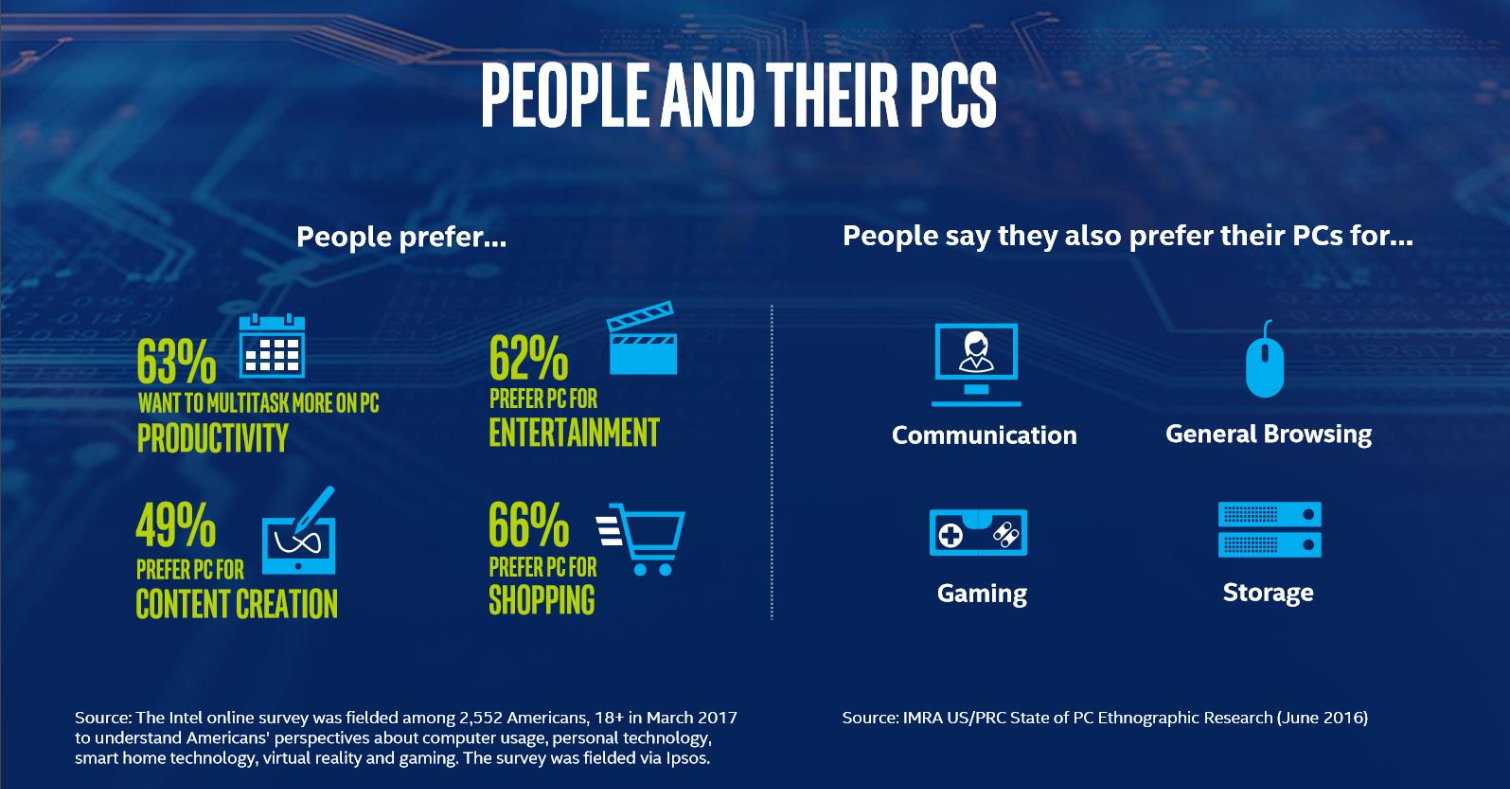

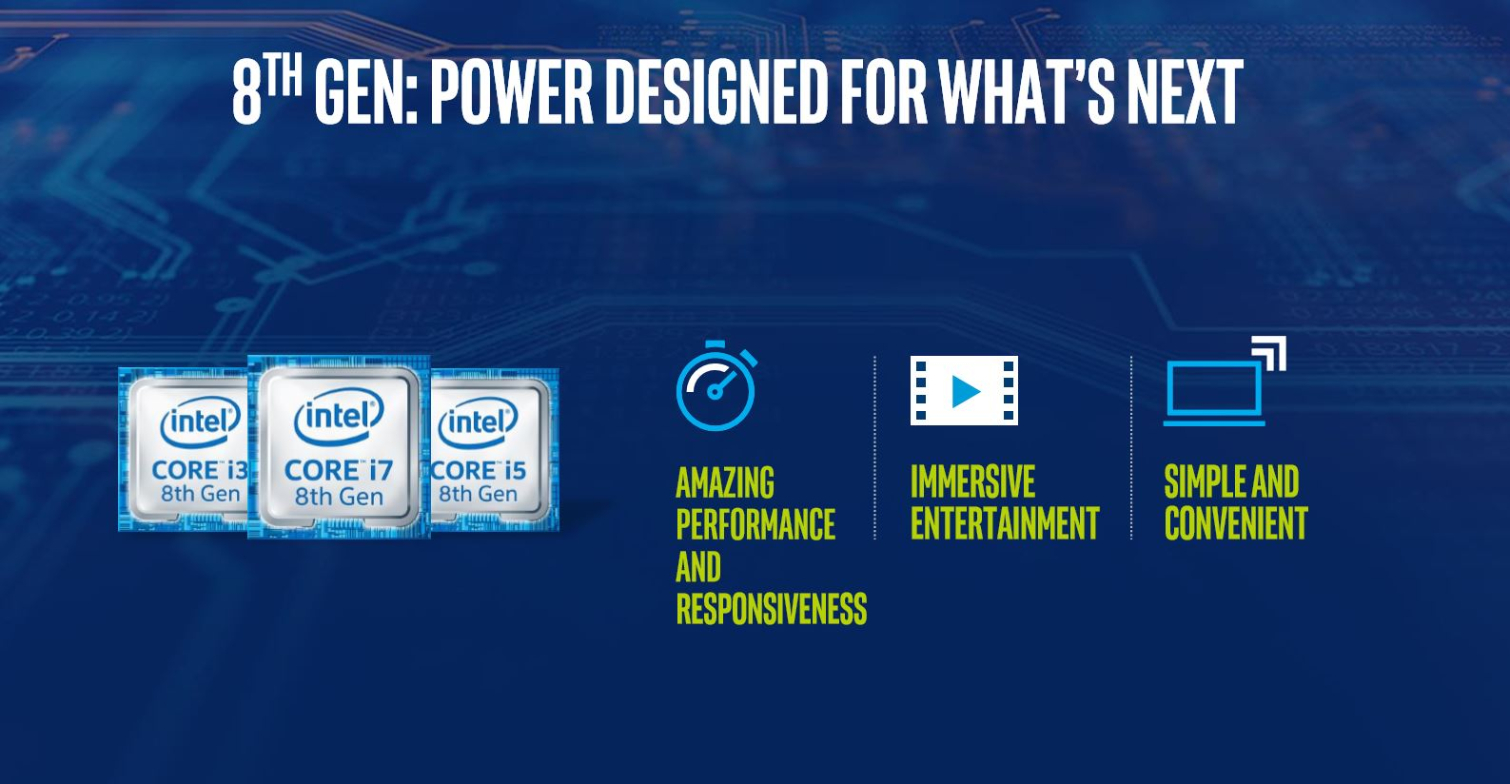
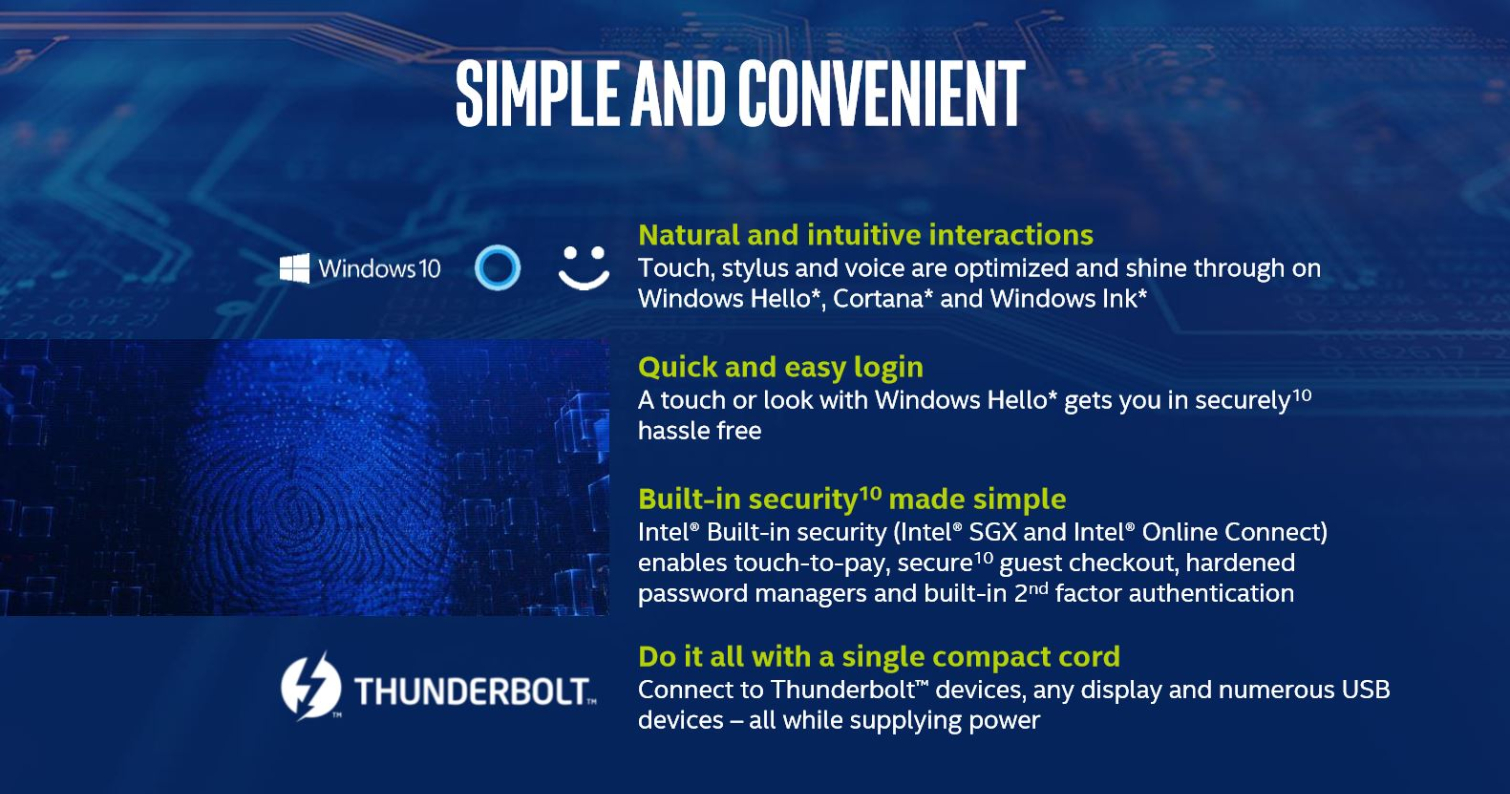
As with all of Intel's U-Series processors, the Kaby Lake-R models are an MCP (Multi-Chip Package) that includes an integrated chipset. These are not socketed processors; they attach to the motherboard with a soldered FC-BGA 1356 package. Intel reminded us that the processors continue to support all of the standard features, such as AES-NI, AVX 2.0, and Quick Sync, among others. Notably, Intel also added support for its Optane Memory products, and it expects OEM models to come to market with the speedy storage caching implementation next spring (2018). The packages also support Thunderbolt connections.
We also get support for the extremely restrictive and elusive 4K video streaming, although Intel indicated that more streaming vendors are coming online with 4K content. Intel's latest also supports mainstream Windows Mixed Reality; however, the Ultra mode still requires a discrete graphics card.
The cTDP Series
All U-Series products feature a configurable TDP (cTDP) range that exploits the DVFS curve. This allows OEMs to tailor mobile products with lower TDP (cTDP-down) settings for increased battery life, or higher settings (cTDP-up) that trade battery life for more performance.
The lower cTDP-down settings allow vendors to cram powerful processors into thinner and lighter devices by easing the thermal dissipation requirements. Unfortunately, this permanent setting lowers performance significantly, and the vendor is not required to disclose the TDP configuration. Many do this with little fanfare. The end user cannot adjust the statically-assigned TDP value.
| Header Cell - Column 0 | KBL-R i7-8650U | KBL i7-7600U | KBL-R i7-8550U | Kaby Lake i7-7500U | KBL-R i5-8350U | KL i5-7300U | KBL-R i5-8250U | KL i5-7200U |
|---|---|---|---|---|---|---|---|---|
| TDP | 15W | 15W | 15W | 15W | 15W | 15W | 15W | 15W |
| cTDP-up Freq. (GHz) | 2.10 | 2.9 | 2.0 | 2.9 | 1.9 | 2.7 | 1.8 | 2.7 |
| cTDP-up W | 25W | 25W | 25W | 25W | 25W | 25W | 25W | 25W |
| cTDP-down Freq. (MHz) | 800 | 800 | 800 | 800 | 800 | 800 | 800 | 800 |
| cTDP-Down W | 10w | 7.5W | 10w | 7.5W | 10w | 7.5W | 10w | 7.5W |
The Kaby Lake-R models feature a much lower cTDP-up frequency than their predecessors, with the considerable deltas ranging from 800-900 MHz, indicating the additional cores have quite the impact on cTDP settings. Intel's Kaby Lake-R models feature the same 800 MHz floor for cTDP-down values, but the alteration only reduces TDP to 10W compared to 7.5W for the previous-gen models. Again, the burden of more cores rears its head.
Intel's processors also support Dynamic TDP, which allows the device to make on-the-fly cTDP adjustments based on sensor feedback such as device orientation or internal and external temperature sensors. Dynamic cTDP adjustments allow throttling when the device is hot, such as outside on a sunny day, to keep the chip within a safe thermal envelope.
Performance Claims


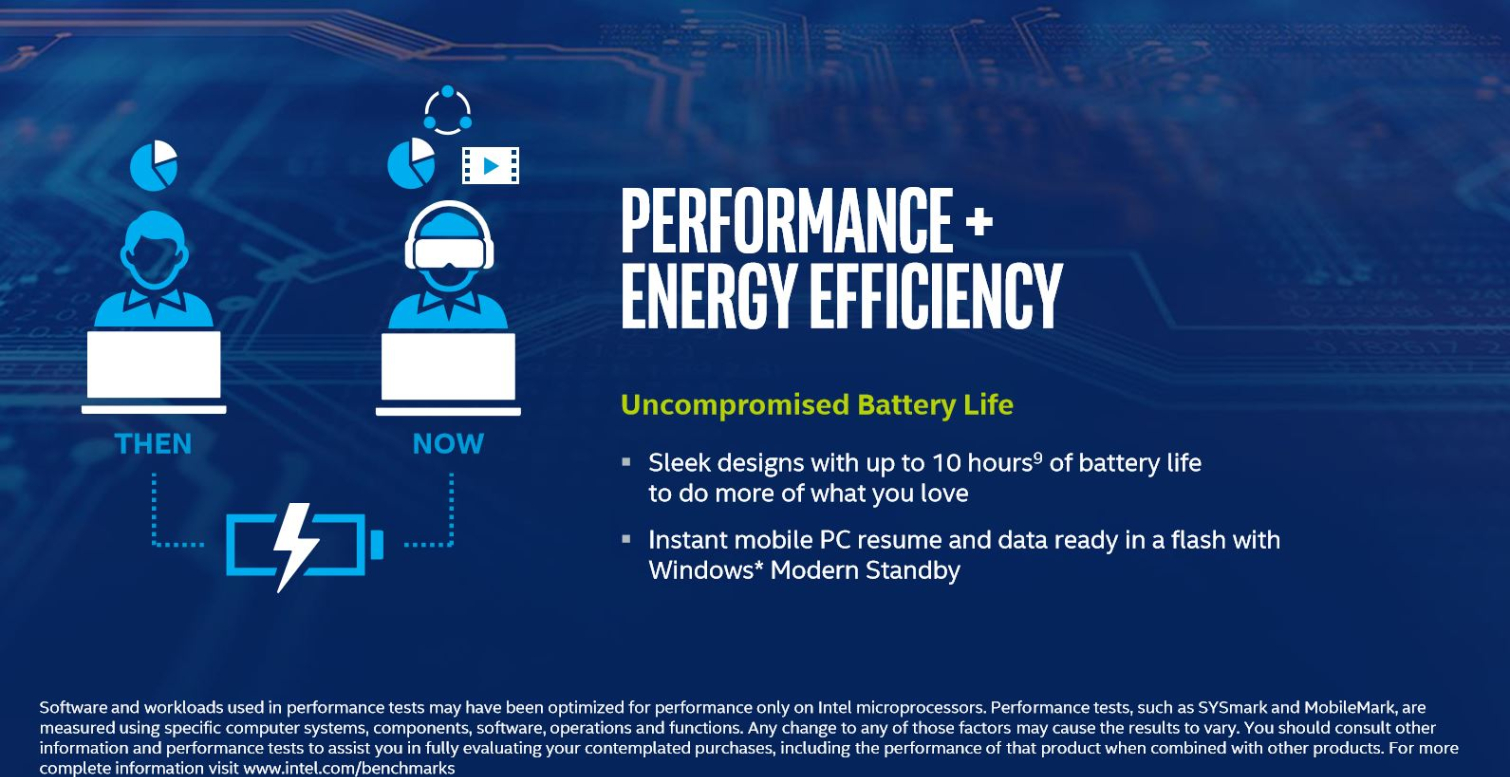

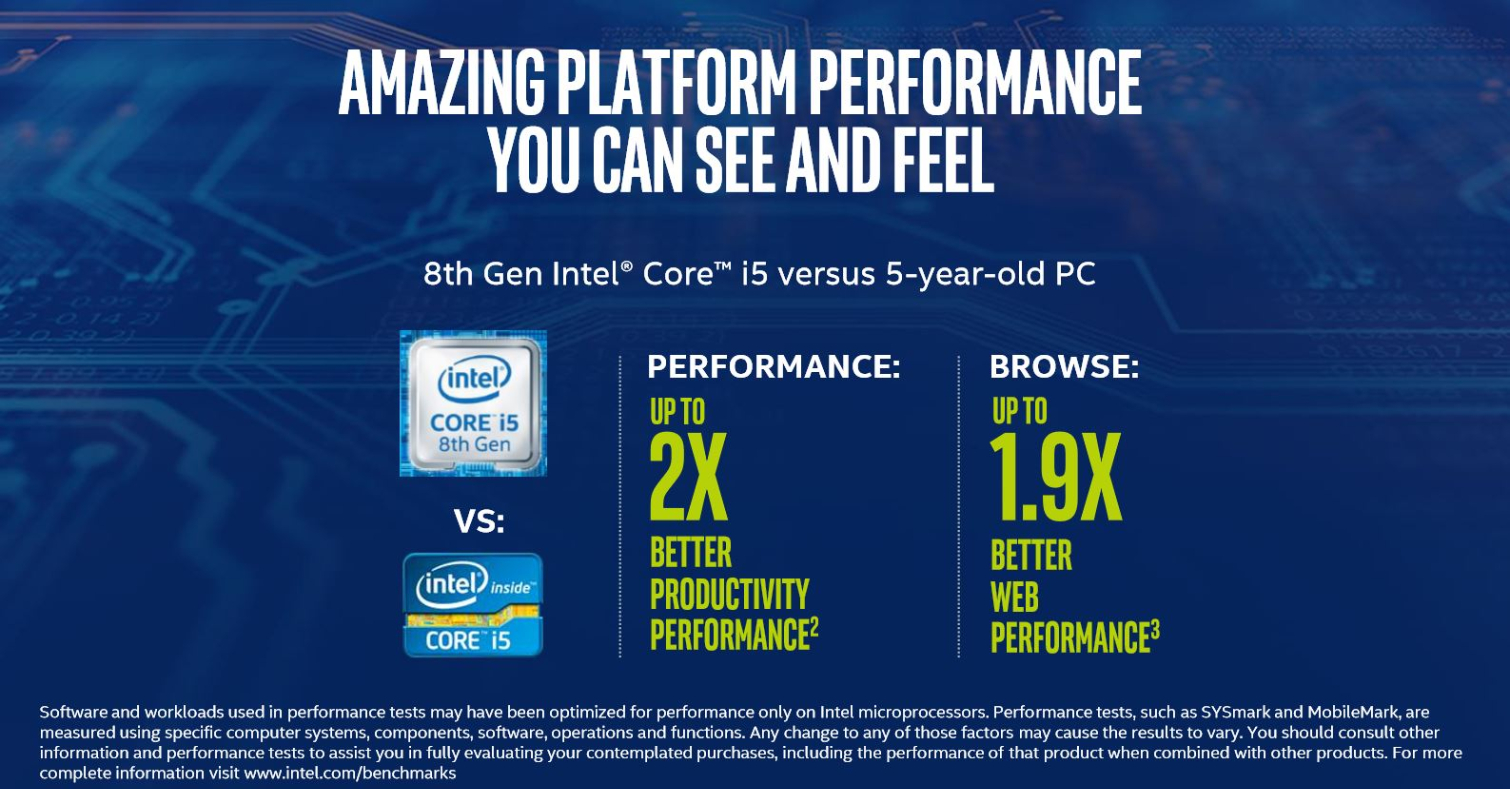

Intel lists a 40% performance increase, which the company claimed is a once-in-a-decade leap in performance. However, Intel measured the performance increase using its own newly-developed Office Productivity and Multitasking benchmark, which consists of an export of a PowerPoint presentation to a 1920x1280 H.264 video presentation while a Word document is simultaneously converted to a PDF file. Intel also threw in an Excel worksheet re-calculation with Slack running in the background. This new test is sure to stir up some debate, but Intel claims impressive performance gains nonetheless.
Intel noted that more than 450 million users are currently on platforms that are five years old (or older). Broadening out the scope of comparison, Intel also claimed that the processor offers up to 2.3X more performance than an Ivy Bridge-era processor (~5 years old), which it feels is representative of a normal customer's refresh cycle.
Intel also touted explosive gains relative to older systems in today's somewhat common tasks, such as creating a 4K video 14.7X faster (a reduction from a 45-minute wait to a mere three minutes). Impressive, sure, but Intel included only the Ivy Bridge system in this comparison. We'd obviously like to see the same test against a 7th-Generation system.
Intel did broaden out its claims to include both 7th-Generation and Ivy Bridge processors for its Adobe Lightroom test, with a 28% and 2.3X performance increase, respectively. The company also treated us to another custom workload that consists of organizing and editing photos to create a slideshow. Intel claimed the workflow experienced a 48% faster completion time compared to the 7th-Gen processors.
All told, many will expect a larger performance improvement from doubling the number of cores, but other factors, such as application scaling and the reduced base frequencies, come into play. We might see more linear performance improvements with workloads that scale perfectly across cores, such as Cinebench, but to Intel's credit, it bases its claims on application-based benchmarks. We've included the test notes at the end of the article in a click-to-expand format so you can peruse the finer details.
Availability
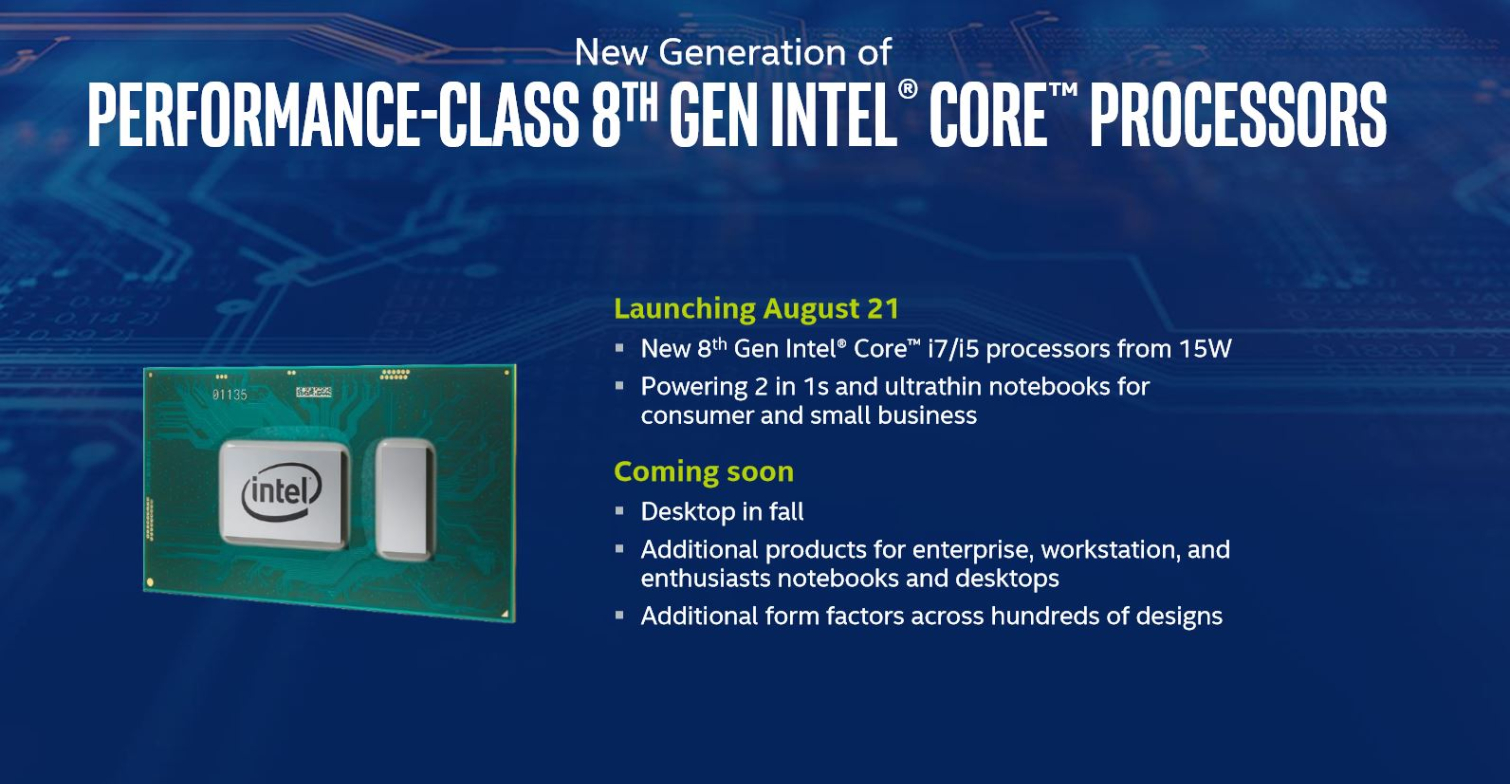


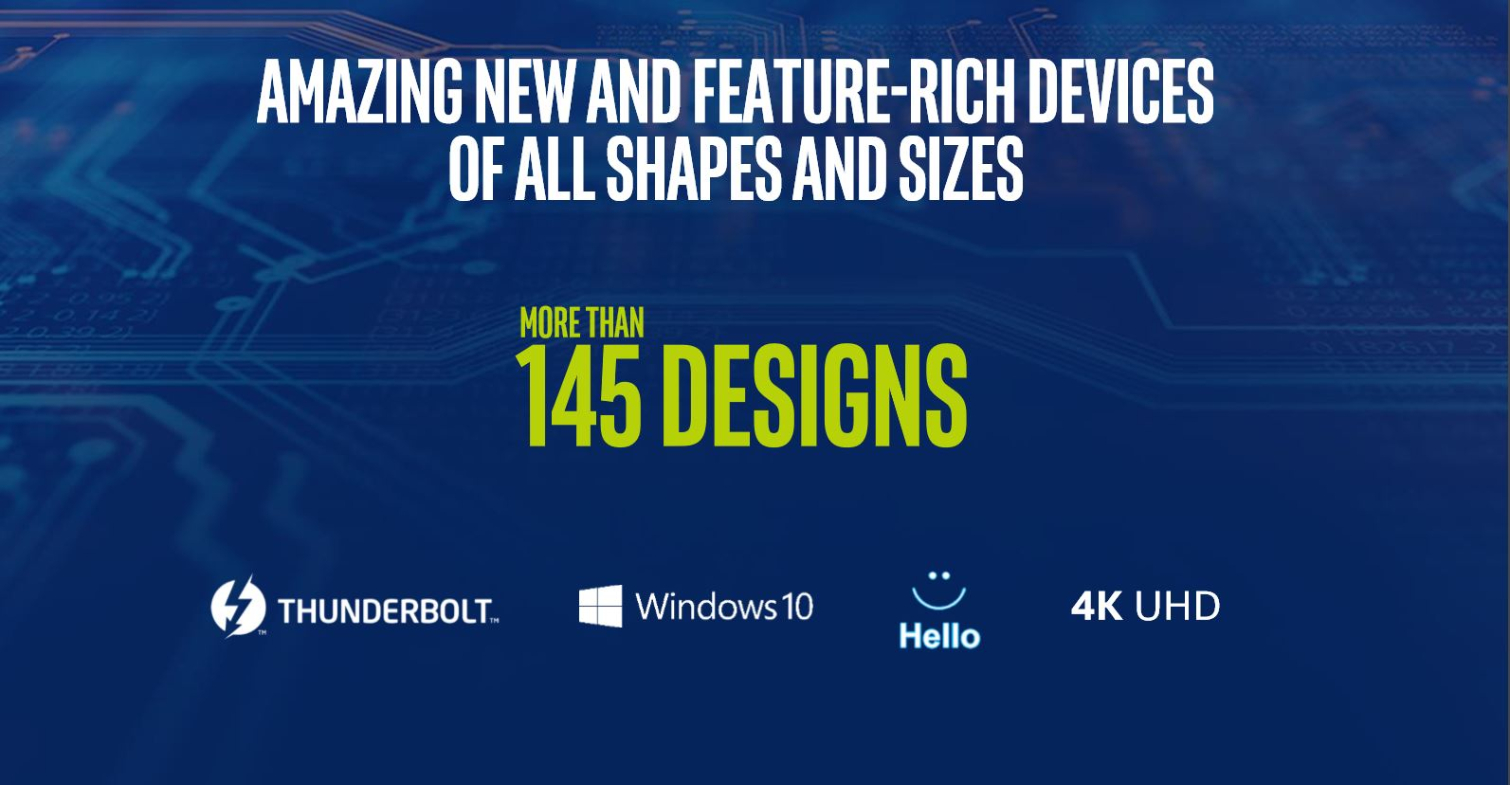
Intel is holding a live webcast, via both Facebook Live and its newsroom, to announce the new processors during the eclipse on August 21. The leading designs will come from OEMs in September, with up to 80 designs on shelves by the holidays. A total of 145 devices will round out the entire product stack over time.
Final Thoughts
Intel isn't sharing product pricing because "OEMs set the end pricing." This is a departure from the norm, as the company has historically revealed pricing for previous-generation U-Series processors. The pricing adjustments are of particular importance because they can give us a decent indication of Intel's pricing strategy as it adds more cores to the lineup, particularly on the Cannon Lake desktop processors. We expect Kaby Lake-R pricing to be posted shortly, and we'll update as necessary.
Intel's shift to a new discombobulated generation of products with three separate architectures is indicative of the challenges the company faces as it attempts to stay on the Moore's Law path. Incessant delays for EUV tools also likely come into play, as that has obviously pushed back Intel's early plans for 10nm deployment.
In either case, the Kaby Lake-R value proposition stems from more cores, threads, and cache, along with improved memory data rates. That should provide a strong boost for multithreaded tasks. Overall, there aren't any explosive IPC or graphics enhancements--this is just a Kaby Lake Refresh after all--but the higher boost frequencies should help in many of the common lightly threaded applications mobile users leverage on a daily basis. The impact of the lower base frequency will be interesting, but Intel's mature Speed Shift should help defray some of the performance-related challenges.
Intel has long planned to chart a new path forward with more cores, but the accelerated launch may be due to AMD's pending Ryzen mobile APUs. Those contenders, which will likely offer the AMD standard "more cores for less" strategy, have yet to come to market. We expect more details in the coming months on AMD's latest, as well as Intel's Coffee Lake rollout, which might also be coming sooner than expected.
-

Paul Alcorn is the Editor-in-Chief for Tom's Hardware US. He also writes news and reviews on CPUs, storage, and enterprise hardware.
-
ibjeepr "These are not the Coffee Lake processors you're looking for"Reply
Are we going to get an announcement on those later today? -
linuxgeex Paul did a really good job of spinning this deception by Intel in a positive light. These are simply not 8-th gen processors, at all. The performance gains are real but what this is about is AMD's recent releases of better-featured and better performance per dollar competition, and Intel choosing to relax its habitual stranglehold on features as a vehicle to drive up profits. That's good value for consumers, but the fact that Intel has made-believe to the public that this is a new generation with new architectural improvements is pretty saddening, regardless of whether they are providing good value with these new SKUs. Deception is never a good thing in marketing, and this is going to damage Intel's reputation among technologists.Reply -
cryoburner Intel: "Hey guys, here's our new generation of CPUs, right on time in Q3! We call it Kaby Lake!"Reply -
InvalidError So the 8000 series is going to be a mix of Kaby-R and Coffee Lake. Hello unnecessary confusion.Reply -
mavikt Intel lost their cool badly upon the Ryzen arrival.Reply
And I've completely lost the grip of their generational codenames; when's there and architectural change and what does it consist of, what's the difference between the process nodes (14nm, 14nm+, 14nm++; less current leak? higher frequencies?).
The tick-tock strategy was very clear to me, the new tick-tock-tack-tack-tack...; not so much.
I'm glad I got my new rig last year, because making an informed buying decision other than 'the newer, the better' is getting real hard.
I guess 'discombobulated' is the word, sounds like mumbo jumbo to me; Can't wait to see what it means! -
MichaelElfial I have to agree with linuxgeex (no matter that I am not linux fan :) ), still what we see is probably indication of something more - Intel did not take AMD seriously way too long, they probably even waited months after the Ryzen release to get really scared. They are simply unable to make a big jump, which will give them enough security for the near future and they are doing what they can - playing with words included. Well, I am not convinced, on the contrary I am a bit worried for Intel in the long run and I (like most of you) appreciate the competition and the long term gifts it gives.Reply -
InvalidError Reply
I wouldn't worry about Intel: it still has the better per-core performance in most software with plenty of cash reserves to tide itself over through the one or two chip generations it may need to re-adjust to Ryzen/TR/EPYC. If Intel really felt threatened, dropping CPU prices to halt AMD's market share gains would also be an option. The simple fact that Intel hasn't announced official price drops for its CPUs should be sufficient evidence that Intel doesn't feel immediately threatened yet beyond the rushed X299 launches to fill market gaps between its previous chips and AMD's new products and those aren't priced to compete on a dollar-for-dollar basis either.20088379 said:I am a bit worried for Intel in the long run
I'll worry about Intel if it still hasn't sorted itself out by mid-2019 where it'll have to compete against Ryzen 2 or possibly even 3.





